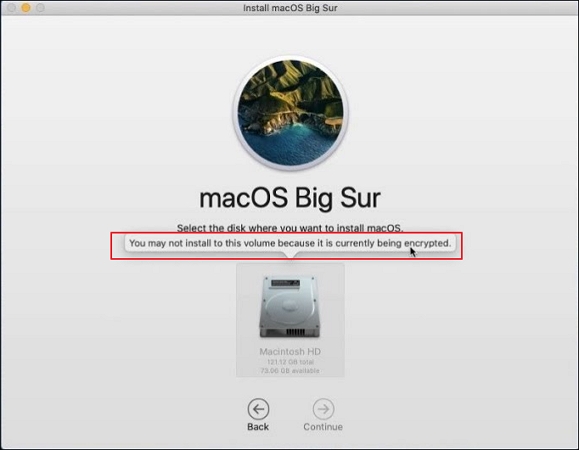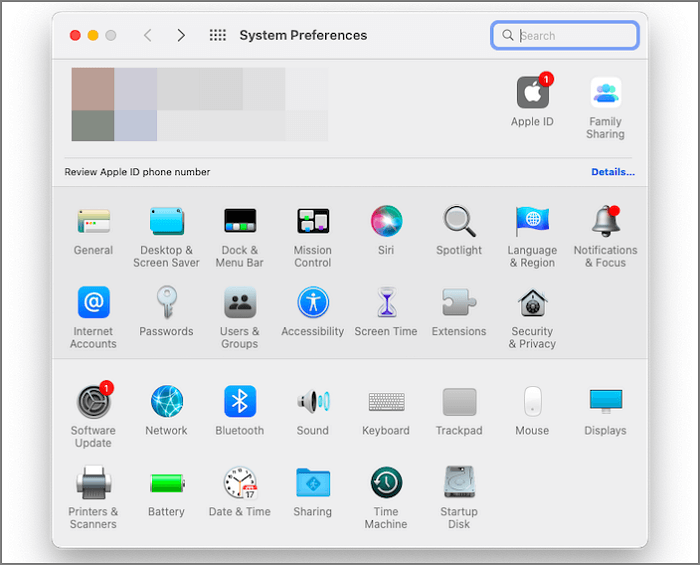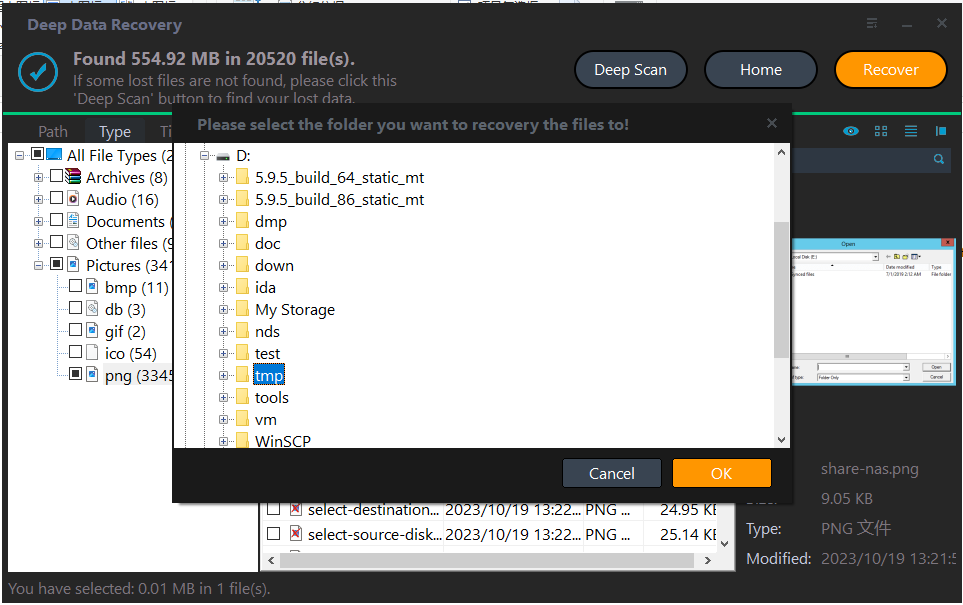You May Not Install to This Volume Because It Is Currently Being Encrypted
If you encounter the error message "You may not install to this volume because it is currently being encrypted" on your Mac, it can be frustrating and leave you wondering about the cause and how to fix it.

This article will explore the reasons behind the encryption process, discuss ways to resolve the issue, and provide guidance on data recovery from an encrypted hard disk. Whether you face this problem or want to understand more about Mac encryption, this guide will provide the necessary information.

How to Encrypt Hard Drive on a Mac with 2 Reliable Methods
Are you worried about valuable data being stolen from your hard drive on your Mac? It is especially applicable for professionals storing sensitive information on the system.
Why the Mac Volume Is Encrypted
When you come across the message "You may not install to this volume because it is currently being encrypted," it indicates that the Mac volume is undergoing an encryption process. Here are some common reasons why this occurs:
🔑Reason 1. Encryption software installed on the computer
If you have installed encryption software such as FileVault on your Mac, it automatically encrypts the disk to protect your data.
⏫Reason 2. Operating System updates
Updating your Mac's operating system, especially to a newer version, may initiate the encryption process as part of the security enhancements.
👋Reason 3. Other causes of encryption
Certain actions, like manually encrypting the volume or configuring security settings to enable encryption, can also trigger the encryption process.
😈Reason 4. Malware or security threats
Sometimes, malicious software or security threats may cause your Mac volume to be encrypted without your knowledge or consent.
🛑Reason 5. Stuck encryption process
Occasionally, the encryption process may get stuck or interrupted due to various factors, resulting in the error message preventing you from installing to the volume.
Understanding these reasons will help you diagnose the cause of the encryption process and determine the appropriate solution.
How to Fix the Currently Being Encrypted Volume on Mac
If you encounter an error message preventing installation due to encryption, several ways exist to resolve the issue. Here are four possible solutions:
- Solution 1. Wait for the encryption process to complete
- Solution 2. Decrypt the volume
- Solution 3. Disable encryption temporarily
- Solution 4. Create a new volume for the installation
Solution 1. Wait for the encryption process to complete
The best action is to be patient and wait for the encryption process to finish. Depending on the size of your disk and the amount of data, the encryption process can take a significant amount of time. Monitor the progress through the encryption status indicator in the Disk Utility or encryption software.
Solution 2. Decrypt the volume
Step 1. You can decrypt the volume if you need to proceed with the installation immediately.
Step 2. Open the "Disk Utility" application, which can be found in the "Utilities" folder within the "Applications" folder.
Step 3. Select the encrypted volume from the sidebar and click the "File" menu.
Step 4. Choose "Decrypt [volume name]" from the dropdown menu and follow the on-screen prompts to initiate decryption.
If one of the methods is helpful to help you install this volume, share it on Facebook, Twitter, Instagram, and other social media platforms!
Solution 3. Disable encryption temporarily
If you wish to install the macOS on the encrypted volume without decrypting it, you can temporarily disable encryption.
Step 1. Click on "Apple menu" > "System Settings" > "Privacy & Security" in the sidebar.
Step 2. Switch to "FileVault", and then toggle "Turn off Encryption".
Solution 4. Create a new volume for the installation
Step 1. If the above solutions do not work or you prefer to keep the current encrypted volume intact, you can create a new volume for the installation.
Step 2. Open the "Disk Utility" application.
Step 3. Select the encrypted volume from the sidebar and click the "Partition" tab.
Step 4. Click the "+" button below the volume layout to create a new partition.
Step 5. Configure the partition size and other settings according to your needs.
Step 6. Once the new partition is created, you can install the macOS on the newly created volume.

macOS Update VS. Clean Install: Which One to Choose
In this guide share the difference between macOS upgrade vs. clean install and which one you need to choose. Read more >>
These solutions should help you resolve the inability to install an encrypted volume on your Mac. However, it's essential to note that decrypting or disabling encryption may compromise the security of your data. Proceed with caution and ensure you have appropriate backups before making any changes.
How to Recover Data from Mac's Encrypted Hard Disk
If you encounter data loss due to the encryption process or any other reason, Deep Data Recovery for Mac can assist you in recovering deleted files Mac. This powerful data recovery software supports the latest macOS Ventura and provides various intelligent data-restoring solutions. With Deep Data Recovery for Mac, you can recover deleted, formatted, or inaccessible files from internal and external hard drives.
Deep Data Recovery for Mac offers a user-friendly interface and advanced scanning algorithms, ensuring a high success rate in data recovery. Some of its main features and highlights include:
- ✅Deep Scan: Conducts a comprehensive scan to recover partition Mac from even the most challenging data loss situations.
- ✅Preview Function: Allows you to preview recoverable files before initiating the recovery process, saving time and effort.
- ✅Selective Recovery: Gives you the flexibility to choose specific files or file types for recovery, minimizing the recovery time.
- ✅Support for Various File Formats: Recovers various file formats, including documents, photos, videos, audio files, archives, and more.
To learn more about Deep Data Recovery for Mac and download the software, follow the steps:
Note: You can create a backup by clicking the "Disk Backup" on the left first. When the disk is damaged or the data on the disk is accidentally deleted or lost, you can get the data back from the backup image.
Step 1. Select the location
Select the disk where you lost data after updating to macOS Sonoma/Ventura/Monterey/Big Sur. Then, click "Search for lost files".

Step 2. Find lost data after the scan
Deep Data Recovery for Mac will immediately scan your selected disk volume and display the scanning results on the left pane. Use the file type and file path to find wanted data on Mac.

Step 3. Recover data after macOS update
Select the target files that were unknowingly lost during or after the update and click the "Recover" button to get them all back.

Final Thoughts
In conclusion, encountering the error message "You may not install to this volume because it is currently being encrypted" on your Mac can be frustrating. However, you can overcome this issue by understanding the reasons behind the encryption process and following the appropriate solutions.
Additionally, if you experience data loss during the encryption process, Deep Data Recovery for Mac is an excellent tool to help you recover your valuable files. We recommend this reliable data recovery software to Mac users who need assistance finding lost files and restoring them effectively.
Not Install to Volume Because It Is Currently Being Encrypted FAQs
Here are 4 additional questions about fixing "you may not install to this volume because it is currently being encrypted". Check here for the answers.
1. What does it mean when your Mac is encrypted?
When your Mac is being encrypted, the disk or volume on your Mac is undergoing a process to convert the data into an encrypted format. This process is typically performed to enhance data security and protect sensitive information from unauthorized access.
2. How do I unlock an encrypted disk on a Mac?
To unlock an encrypted disk on a Mac, follow these steps:
- Step 1. Open the Disk Utility application on your Mac.
- Step 2. Select the encrypted disk from the sidebar.
- Step 3. Click on the "File" menu and choose "Unlock [disk name]."
- Step 4. Enter the password associated with the encrypted disk and click "Unlock."
3. How to install macOS on an encrypted disk?
To install macOS on an encrypted disk, you can either wait for the encryption process to complete before initiating the installation or create a new volume for the installation, as explained in Part 3, Solution 1, and Solution 4.
4. What does it mean when a volume is encrypted?
When a volume is encrypted, the data stored on that particular volume is converted into an encrypted format, which requires a decryption key to access. This encryption process protects the data from unauthorized access and ensures its confidentiality and integrity.
Related Articles
- How to Lock Mac Screen [7 Fast Ways to Lock Mac]
- Top 8 Hard Drive Temperature Monitor Software for Windows [Pros & Cons]
- Fixed: Windows 10 Will Not Update with Error Code 0x80240fff
- Wi-Fi not Working on Laptop, but Working on Phone | Solutions